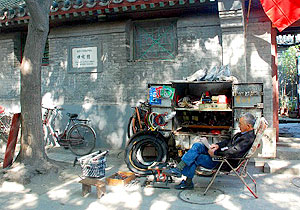Beijing Hutongs

Beijing's Hutongs are the alleys and laneways that run between the city's old traditional siheyuan housing. Siheyuan are residences that were constructed by building four houses around a rectangular courtyard center. As these were built beside each other they formed the hutongs which in turn created communities. These are now a place for visitors to get a glimpse of old Beijing and see how most of the the locals used to live.
Hutongs began to be built during the Yuan Dynasty (1271-1368) and this continued through the Ming (1368-1644) and Qing (1644-1912) Dynasties. The name is said to come from the Mongolian word Hottog, meaning well. People would dig a well and make their houses around it. The hutongs vary in width and length depending on the area. Most of Beijing's hutongs were built around the Forbidden City area on north-south and east-west axis's in accordance with Feng Shui principles. Richer people of higher status built siheyuan with larger luxurious houses and bigger courtyards and made their hutongs wider than those of the poorer average local, whose homes were much simpler and smaller. They range from about 10m to as small as 40cm in width.
During the 20th century and especially since the founding of the People's Republic of China in 1949, the number of hutongs has been dropping rapidly. This is due to continued modernisation and development of the city, although the city has designated some protected areas in order to preserve a part of Beijing's historic past. Zhuanta Hutong, located to the west of Beihai Lake is believed to be the oldest surviving hutong and dates back to the Yuan Dynasty.
The remaining hutongs still hold thriving communities and are a great place to wander around or take a rickshaw tour through. Shichahai is a district known for its hutongs that includes the Qianhai, Houhai and Xihai lake areas. One of the most popular hutong areas to visit is the one around Houhai Lake which includes the Yangfang hutong. There are many around the Yinding Bridge which connects the Houhai Lake and Qianhai Lake areas, such as Dajinsi and Xiaojinsi which are quite well preserved. Visitors enjoy walking from this area towards the Bell and Drum tower area as there are many hutongs along with shops, stalls and restaurants among the streets between, as well as some former residences of famous Chinese people.